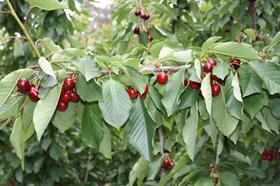
Over the last few years Tasmania’s cherry industry has been marked by a large number of new plantings, prompting industry figures last year to predict the island state would hit 8,000 tonnes of production by 2012.
But with the rate of new plantings slowing over the past 12 months, that prediction has been revised to 7,000 tonnes by 2014/15 for the late-season producer.
As the new season approached, the early predictions are of a 4,000 tonne crop, according to Lucy Gregg, business development manager for peak body Fruit Growers Tasmania.
“Some areas of Tasmania have been quite dry up until recent rains – such as the Coal River Valley – so the wet `winter` has not been an issue,” she told Fruitnet.com. “Unlike last year where an exceptionally wet winter saw tree losses in some orchards. Some orchards are still recovering from last year but the signs all look good.”
New orchards are still being put in, she said, with a slow movement from tender varieties like Kordia and Regina to hardier and later varieties. Many of those new orchards are also moving into later producing regions to take advantage of that market window.
On the export front, as with all of Australia’s exports, the high value of the dollar is expected to have an impact in more price sensitive markets, but Ms Gregg said large premium fruit – the market segment Tasmania generally aims for – tended to withstand currency fluctuations more easily.
As a consequence of Tasmania’s pest free status, the state has greater access to a number of markets than cherries from the Australian mainland, the season for which is several weeks earlier.
Japan is one of those markets – Tasmania’s exports there are spearheaded by grower-exporter Reid Fruits, which ships premium white-fleshed Japanese varieties to the market. “Japan continues to grow at a steady rate and there is plenty of potential in the market,” said Ms Gregg.
Korea is another growing market for Tasmania. Access to Korea was only granted in February this year, in time for some small trial shipments at the end of last season.
“South Korea will no doubt become one of our key markets but it will take some time to build,” Ms Gregg told Fruitnet.com. “Saying that, we believe that there has been exceptionally strong commercial enquiries for Tasmanian fruit so we could expect that in our first full season we could see some good volumes go into the market.”
Exports to Russia are expected to be strong again this season, but sales to Europe will likely be limited to spot supply of premium fruit because of the high Australian dollar.
Sales in the US will be similarly limited, but Ms Gregg expected that over the next few seasons those markets will become less important as sales to South Korea and – pending access – mainland China increase.



